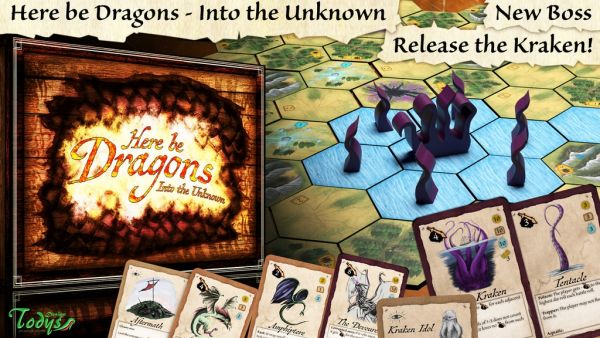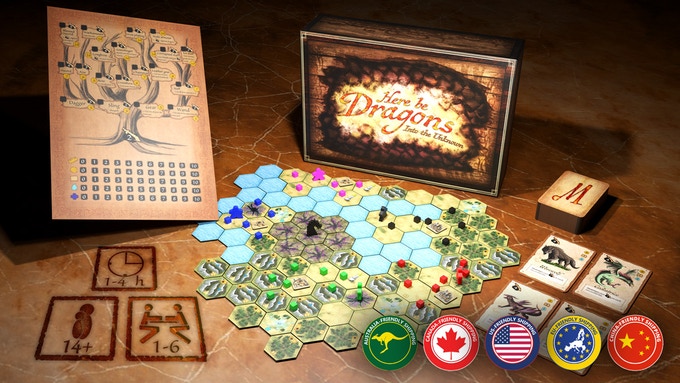Preview: Discover a Land of Monsters and Magic in Here Be Dragons

You have landed on the shores of a new, undiscovered country. Strike out into this new world, build settlements, and explore. But beware: for here be dragons and your fellow explorers may turn against you as well.
Currently on Kickstarter, Here Be Dragons is a tile placement exploration game, with elements of strategy and push-your-luck combat.
Gameplay
Each player sets their character meeple on the starting tile, and places their travel marker along one of the tile's six sides.
At the start of each turn, if you have a travel marker in place along an edge with no tile, you draw a tile from the bag and place it along that edge. You then move your character onto this new tile. The exception to this is if you drew a water tile without a harbor icon on it. You can only move onto water through a harbor, so instead you place it adjacent to any other water tile on the board and then draw another tile to move to.
If your travel marker was pointing towards an already placed tile, then you simply move onto it. If you move into an area controlled by another player, you must pay one gold upon entering it. If you are on a plain tile or a water tile, you may move up to three spaces if all those spaces are of the same tile type; otherwise you may only move one tile at a time. You may replace your travel marker at the end of your turn. Alternatively, you can skip placing your marker when on a settlement to regain three points of health.
At the start of your turn, after you have moved, you draw an event card. Some event cards are quests which are put out on the table, offering rewards for the first player who completes the task written on them, some are events that take place at once, and some are item cards that go into your hand.
There are four types of resources you are collecting in the game: gold, resources, influence points, and victory points.
On your turn you may build or upgrade a settlement or occupy a specific tile with district cubes. Each player may have one settlement on the board. It starts as a village, which must be placed on a plain tile that is not already occupied. In order to upgrade it you must place district cubes on adjacent tiles that are also not already occupied. Some tiles have production buildings on them, such as a mine or a sanctuary. These, when occupied by a district cube, earn you extra resources or influence each turn. You may only place a district cube on a tile that is adjacent to a tile that already has one of your cubes on it. You can upgrade your settlement three times, each time earning influence and victory points. The size of your settlement also determines how much income it will generate for you each turn.
Some tiles also show a monster icon. When on these tiles, you can roll to search for monsters. If you roll three to six, you draw a monster card whose difficulty level matches the number shown on the tile. You may then choose to flee, succeeding on a roll of one to three. If you flee, you place a monster token on the tile. District cubes cannot remain on a space with a monster token, so this is a way to sabotage your opponent.
If you fail to flee or choose not to, you must fight the monster card you drew. The monster card shows how many attack dice it has. Players start the game with two attack dice, but can upgrade their weapons by spending gold on a tech tree which can give them more dice.
In battle, both sides roll their dice (you may choose to use any item cards you have in hand). Both sides then line up their dice in order of highest to lowest and compare the results with higher dice knocking out lower dice. So, for example, if you rolled a six, five, and three and the monster rolled a six and a two, the two sixes tie and then the five knocks out the two.
Once the results have been compared, any remaining dice are rolled again. This continues until one side is all out of dice. If a player won, he wins the rewards shown on the card. If the monster won, the player loses health points equal to the monster’s strength and a monster token is placed on the tile location to be encountered later.
A player can also spend influence points to attack another player with more victory points than they have. You may not be attacked when on a settlement or sanctuary. Combat works the same way, with both players being able to play item cards. The player who wins steals two victory points from the loser and the loser loses health equal to the number of dice the winning player started the fight with.
There is also a boss monster variant you can play with, in which case there is a particularly strong monster with special rules, such as cards that are drawn from the event deck to trigger its abilities. This monster must be defeated or he has the ability to make everyone lose the game.
Before the game starts, players agree if they are playing to five or ten victory points. The first player to reach the agreed upon number wins the game.

First Impressions
Here Be Dragons has a fun blend of tile placement exploration and monster fighting. It captures nicely the sense of arriving on a new land, and finding the best spot to lay down your settlement, while continuing to explore outward.
All the player interaction is intriguing, with the option to directly attack each other or use monsters to sabotage your settlements. Also, since you cannot place a district cube on a space with another player’s, you can also get in each other’s ways and block the path to valuable tiles. The quests also add an extra level of competition, as you compete to be the first to complete their requirements.
The game also has a number of catch-up mechanics in place, from allowing players who are further behind to attack those in the lead, to giving the player in last place the extra resources if your income phase would earn you more than you are allowed to hold.
A nice range of variety in the monsters, tile types, and event cards should ensure plenty of replay value and keeps things a little unpredictable. The fact that players stake out where they’ll be moving next round at the end of their current turn also gives other players some information on which to base their own plans.
The combat is simple but has some elegance to its push-your-luck style of gameplay. Different monsters have various special abilities that can affect how their combat plays out, while the choices you make on your tech tree combined with the item cards you collect allows you to steadily grow stronger and tackle more difficult monsters.
The game is a bit heavy on rules, ranging from travel, to combat, to leveling up your settlement. None of it seems too hard to grasp, so once you know it, it should be easy to keep the flow of the game going, but it will make the initial learning of the game a little long.
Here Be Dragons is currently on Kickstarter and seems worth checking out — it’s a fun blend of genres with the theme of discovering a brand new land.
Disclosure: this preview is based on our first impressions of a draft of the rulebook and game components, which are subject to change prior to publication. We received a modest payment to write this article.




